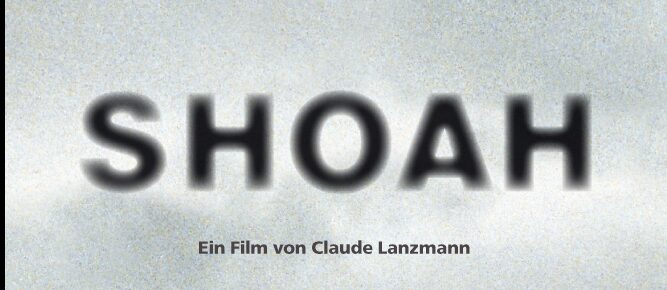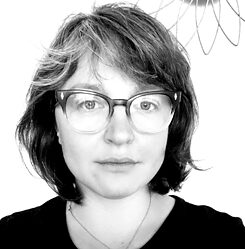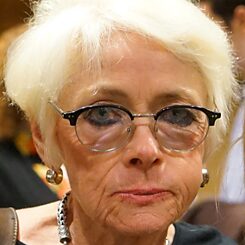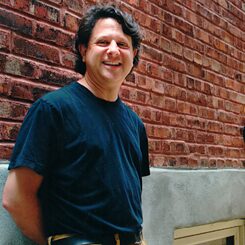Es ist nicht einfach, über SHOAH zu reden. Es gibt Magie in diesem Film und Magie lässt sich nicht erklären. […] Trotz all unseres Wissens, blieb die schreckliche Erfahrung nicht greifbar. Zum ersten Mal erleben wir sie in unseren Köpfen, unseren Herzen, unserem Fleisch... - Wir sind uns bewusst, dass wir hier ein großes Kunstwerk betrachten. Ein wahrhaftiges Meisterwerk.
Simone de Beauvoir
 © Claude Lanzmann
© Claude Lanzmann
1. Teil: Montag, 27. Januar 2020
Einführung: Erin Corber, PhDFor decades after the Holocaust, Auschwitz functioned as a symbol, overshadowing what historians have since come to understand as a complex system of ghettos, camps, slave labour installations, and open-air massacre sites stretching from Western to Southern Europe, to the Balkans, to even North Africa, and deep into Eastern Europe and the former lands of the Soviet Union. […]
Yet the archives – incomplete and imperfect, either deliberately or naturally – cannot account alone for a full understanding of the historical and human dimensions of the Holocaust. Killing centres like Treblinka and Sobibor, massacre sites like the Ponary forest in Lithuania, dismantled, abandoned, and replanted over before the Soviet advance, left very little in terms of the physical evidence, especially when compared to the standing barracks, gas chambers, and crematoria of Auschwitz. There are very few descriptions of these sites in the historical record. […] Where the physical evidence on many of these locations was lacking, human survivors were also few and far between. […]
While memory and accuracy continue to be critical issues in assessing the content and context of a survivor’s testimony, witnesses have become essential voices in our conversations on genocide. Shoah was one of the very first films to allow these voices bearing witness to stand alone, front and centre. […]
Shoah links the experiences of extermination camps like Treblinka, Chelmno, and Sobibor to those of Auschwitz, the one concentration and extermination camp that has come to dominate popular perceptions of Nazi genocide. Shoah blends images of contemporary lands together, allowing us to imagine the expansiveness and mundane nature of the landscapes of killing. The film spans the recognizable Auschwitz site with its wrought iron gates. We also see rather seemingly ordinary sleepy railroads, lush green fields and forests over which killing centres once operated and under which mass graves lie. We see ordinary Polish villages and dirt roads seemingly unchanged, fixed in time. These geographies are part of the story, and help us feel closer to the past than would an archival image of the same place from the 1940s. […]
Erin Corber
Erin Corber ist Historikerin mit Forschungsschwerpunkt auf dem modernen Europa und das moderne Judentum mit besonderem Interesse am öffentlichen jüdischen Leben im Frankreich der Zwischenkriegszeit. Sie arbeitet derzeit als Graduierten-Karriereberaterin an der Universität McGill und ist wissenschaftliche Mitarbeiterin des Instituts für Kanadische Jüdische Studien an der Universität Concordia.
2. Teil - Mittwoch, 29. Januar 2020
Naomi Kramer: Reflections on ShoahWilliam Faulkner observed: “The past is never dead. It’s not even past.” For many of us, the film “Shoah” affirms this observation. It is essentially the past re-enacted by interviewees who Lanzmann refers to as actors.
[…]
As the Nazi regime developed over the years, the whole structure of decision-making was changed. At first there were laws. Then there were decrees implementing laws. Then a law was made saying, “There shall be no laws.” Then there were orders and directives that were written down, but still published in ministerial gazettes. Then there was government by announcement; orders appeared in newspapers. Then there were the quiet orders, the orders that were not published, that were within the bureaucracy, that were oral. Finally, there were no orders at all. Everybody knew what he had to do.
Hiberg notes, "In all of my work I have never begun by asking the big questions.[...] I have preferred therefore to address these things which are minutiae or detail in order that I might then be able to put together in a gestalt a picture which, if not an explanation, is at least a description, a more full description, of what transpired."
[...]
Without Raul Hilberg we may not have understood, and certainly not in the same way, debates about when that ‘Final Solution’ was designed, about what the essential conditions for genocide were, about the extent of criminality and complicity within the organised German community, about the responses of the bystanders, or notoriously about the reaction of the Nazis’ Jewish victims. To this day historians of the Holocaust invariably salute The Destruction of the European Jews as a ‘masterly analysis’ and an ‘unsurpassed landmark’, agreeing that amongst Holocaust historians ‘none is more influential than’ Hilberg in having set the agenda for Holocaust research.
[...]
A “fiction of the real” Lanzmann’s term, does not attempt to represent reality as it was allegedly experienced but instead, respects the limits of representation and the inherent impossibility of representing horror itself. It refuses to substitute for or cover over the remaining material evidence of annihilation or to create narratives, representations, fictions, or dramas that would hide or mitigate the effects of the “nothingness” still evident in the present.
In fact, understanding never was Lanzmann’s purpose. He provocatively laid claim to an epistemological stance whose precise definition was provided by an SS guard: “Here, there is no why” a comment referred to by Primo Levi in “Is This A Man.”
Naomi Kramer
Naomi Kramer ist die Präsidentin und Gründerin der Stiftung zur Aufklärung über den Holocaust und zur Verhinderung von Völkermord (Holocaust Education and Genocide Prevention Foundation, kurz: HGEP), deren Aufgabe es ist, die Öffentlichkeit über die zerstörerische Kraft von Vorurteilen und Diskriminierung aufzuklären. Naomi arbeitet seit 28 Jahren mit dem Gedenkdienst-Programm und wurde kürzlich mit dem Goldenen Ehrenzeichen für ihre Verdienste um Österreich ausgezeichnet.
Laden Sie hier den gesamten Text herunter:
TEIL 3 : Donnerstag, 30. Januar 2020
Norman Ravvin: Different Ways of Remembering, Different NamesIntroductory talk for a final screening of Shoah
The first thing I’d like to raise […] is a consideration of names and their importance for what we know about the Holocaust. When the events of the war were taking place, Jews who were experiencing them did not use the words we use now to describe what was happening. Rather, anyone who spoke Yiddish – and a large number of the victims did – recognized they were confronting a churbn, a Yiddish word with Hebrew roots, which refers to a calamity or catastrophe. [...] Of course, in English-language and especially in mainstream, non-Jewish contexts, this was not the word of choice. Rather, the word Holocaust named the German destruction of European Jews, their culture and communities. Its use can be attributed to wartime developments, and in this, in some way, one could say it circulated alongside churbn while the events of the war raged. [...] The shift to Shoah – a Hebrew word one finds in the Bible, as well as in modern Hebrew dictionaries, which means utter destruction – is the outcome of a number of influences on Holocaust commemoration and education, which were motivated by Israeli scholarship and modern Hebrew discourse in the late 1960s and after. As Lanzmann embarked on his filming, interviewing some of his subjects in Israel where they had emigrated after the war, he must have felt this shift taking place in the broader culture. One could add, too, that the Yiddish word, churbn, would have had no place in his imagination.
[…] You have noticed, of course, that as Lanzmann tours Poland, filming it in the 1970s and early eighties, that his interviews reveal how the German occupation and decimation of Polish society included an unflagging project of renaming. Lodz, the major manufacturing centre near to one of the killing sites that Lanzmann returns to again and again, became Litzmannstadt. Mlawa, a small cosmopolitan city on the western front where my family lived until the outbreak of war, became Millau. The German Kulmhof became the name of the village of Chelmno, on the outskirts of Lodz, where Lanzmann visits a terrible killing site.
This aspect of wartime Poland – the obliteration of its names, names of people, names of places – leads me to raise an aspect of Shoah that I view as one of its challenges. In its cinematic portrayals, Lanzmann has decided to forego the usual documentarian’s use of archival film and photographs, of which, you must know, there is a great deal, much of it taken by Germans in the process of the activities being described in the film.
Norman Ravvin
Norman Ravvin ist Schriftsteller und Dozent. Er ist Fakultätsmitglied in der Abteilung für Religionen und Kulturen der Universität Concordia und hatte lange Zeit den Vorsitz am Institut für Kanadische Jüdische Studien. Seine kritischen Essays zur Literatur und Geschichte des Holocaust sind in A House of Words: Jewish Writing, Identity, and Memory gesammelt.
Hier finden Sie Informationen über seinen neuesten Roman The Girl Who Stole Everything.
Ich hatte eine Erinnerung an das verkommenste Kapitel der Menschheitsgeschichte gesehen. Aber ich hatte auch einen Film gesehen, der das Leben so leidenschaftlich bejahte, dass ich nicht wusste, wohin ich mich mit meinen verwirrten Gefühlen wenden sollte. Es gibt keine angemessene Antwort auf diesen Film. Er zeigt eine ungeheure Realität, er ist ein 550 Minuten lang andauernder Scherz- und Wutschrei angesichts dieses Völkermords. Es ist einer der edelsten Filme, die je gedreht wurden.
Roger Ebert



